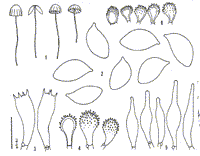|
 Marasmius fishii Marasmius fishii
BiostatusPresent in region - Indigenous. Endemic
Images (click to enlarge) | 
Caption: Fig. 11 (1-6). Marasmius fishii G. Stevenson (ZT 67-128).- 1. Basidiomes.- 2. Basidiospores.- 3.
Basidia.- 4. Cheilocystidia a).- 5. Cheilocystidia b).- 6. Pileipellis. |
Article: Stevenson, G. (1964). The Agaricales of New Zealand: V. Kew Bulletin 19(1): 1-59.
Description: Pileus 2 mm diam., chestnut brown to dark blackish brown at centre, campanulate, radially plicate, margin scalloped; flesh extremely thin, dry and tough. Gills adnexed, white, distant, in one series. Stipe 5-10 x 0.1 mm, blackish brown, smooth, tough. Spores 9-11 x 6 µm, non-amyloid, hyaline; print white. Cuticle with broom-cells 15 x 10 µm with dense brown colour (Fig. 18).
Habitat: Inserted on dead leaves of Phormium, Lake Ngapouri, Rotorua,3.9.1960, G. R. Fish in G. M. Taylor (type).
Article: Desjardin, D.E.; Horak, E. (1997). Marasmius and Gloiocephala in the South Pacific Region: Papua New Guinea, New Caledonia, and New Zealand taxa. Bibliotheca Mycologica 168: 152 p.
Description: Pileus 1.5-3.0 mm diam, hemispherical to convex, disc not depressed, papilla absent, margin
strongly plicate and scalloped; surface dull, dry, glabrous; deep reddish brown to chestnut brown
overall. Texture membranaceous; context very thin, dingy buff to concolorous with the surface.-
Lamellae adnexed to subfree, distant (6-7), lamellulae absent, narrow, white; edges even,
concolorous.- Stipe 5-14 x 0.2-0.3 mm, central, equal, wiry, tough, glabrous, insititious, black
overall; rhizomorphs absent.- Odor and taste not distinctive.
Basidiospores11.5-13 x 6.5-7.0 µm, broadly ellipsoid to broadly fusoid, smooth, thin-walled,
hyaline, inamyloid.- Basidia 25-35 x 10-11 µm, 4-spored, clavate, clamped.- Cheilocystidia of 2
types: a) Rotalis-type cells 15-20 x 8-12 µm, broadly clavate, hyaline; divergent setulae 1-2 x 1 µm,
cylindrical, hyaline; b) 30-45 x 6-10 µm, fusoid to lageniform-lanceolate, hyaline, thin-walled.-
Pleurocystidia absent.- Pileipellis hymeniform, mottled, composed of Rotalis-type cells; main body
12-25 x 6-16 µm, apically dark red-brown and thick-walled (up to 4 µm), base hyaline and thin-walled; divergent setulae 1-3 x 1 µm, cylindrical.- Pileocystidia absent.- Tissues inamyloid, non-gelatinous.- Stipe tissue monomitic; cortical hyphae parallel, cylindrical, smooth to roughened, not setulose.- Caulocystidia absent.-Clamp connections present.
Habitat: Habit, habitat and distribution.- Solitary, in groups on rotting leaves of Phormium tenax
(Agavaceae). New Zealand.
Notes: Marasmius fishii forms minute basidiomes with deep reddish brown pilei, non-collariate and non-marginate lamellae, a short, black, glabrous, insititious stipe, growth on Phormium leaves, large
basidiospores, two types of cheilocystidia, smooth stipe cortical hyphae, and the absence
pileocystidia, pleurocystidia and caulocystidia. The species is macromorphologically similar to M.
minutus Peck, an uncommon species from eastern North America and Europe. Marasmius minutus
differs, however, in forming much smaller basidiospores 6.0-9.5 x 3-4 µm, numerous fusiform to
lageniform pleurocystidia and pileocystidia, setulose stipe cortical hyphae, and grows on
dicotyledonous debris (Holotype, NYS!). In the field, M. fishii might be confused with M.
exustoides Desjardin & E. Horak which also grows on monocotyledonous leaves (Cordyline), but
the latter species differs in forming narrower basidiospores (4-5 µm broad), and large, clavate
pileosclerocystidia with coarse reddish brown incrustations on the pileus disc.
|